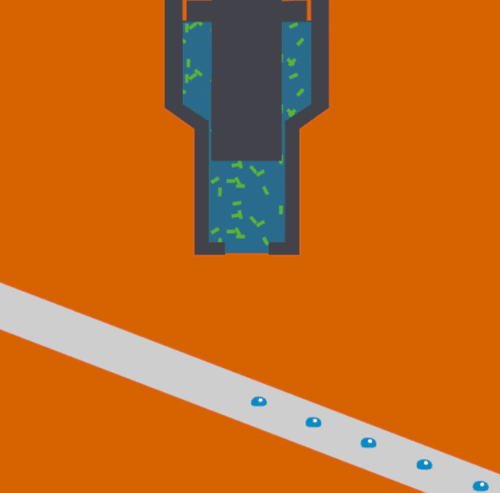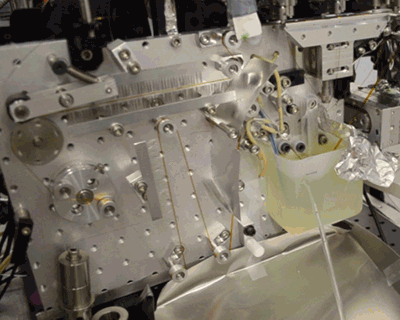Conveyor Belt Innovation Speeds Up Biological Discovery
March 8, 2017

Acoustic droplet ejection allows scientists to deposit nanoliters of sample directly into the X-ray beam, considerably increasing the efficiency of sample consumption. A femtosecond pulse from an X-ray free electron laser then intersects with a droplet that contains protein crystals. (SLAC National Accelerator Laboratory)
This news release was issued on Feb. 27, 2017, by the U.S. Department of Energy's (DOE) Lawrence Berkeley National Laboratory. For this research, Babak Andi from DOE's Brookhaven National Laboratory was part of the team at the Linac Coherent Light Source at SLAC National Accelerator Laboratory that developed a new assembly-line system—called "acoustic droplet ejection droplet on tape" (ADE-DOT)—that uses sound waves to rapidly deposit as many as 120 sample-containing droplets each second onto a conveyor belt. As the droplets containing tiny protein crystals ride along on the conveyor belt, they are then exposed to x-ray pulses while detectors collect diffraction data for analysis. With this new technology and method, scientists can study biomolecule structures and reactions in real-time at room temperature, revealing time-resolved, never-before-seen step-by-step views of dynamics in biocatalyst reactions at the molecular level. The work builds upon technologies developed by scientists in the Life Science and Biomedical Research Resource at National Synchrotron Light Source II (NSLS-II) as well as members of the former Protein Crystallography Research Resource at NSLS-II's predecessor facility, NSLS. LCLS and NSLS-II are DOE Office of Science Users Facilities.
The XFEL beam is so powerful that experiments have been described as “diffract and destroy,” where the crystals containing biological molecules are obliterated within nanoseconds after initial exposure. Previously, most researchers used injectors to deliver a continuous stream of crystals to the beam, but this wastes a large portion of purified biological sample and limits the scope of systems that can be studied. The new method, dubbed the “Droplet on Tape” (DOT) method, exposes a single drop of the crystalline material to the beam at one time and allows for simultaneous physical analysis using other modes of detection (diffraction, spectroscopy, or scattering).
Acoustic droplet ejection (ADE), a method developed in collaboration by scientists at Berkeley Lab and Brookhaven National Laboratory, allows researchers to deposit tiny nanoliter drops of sample directly into the X-ray beam, considerably increasing the efficiency of sample consumption. Study senior author Junko Yano, senior scientist in the Molecular Biophysics and Integrated Bioimaging Division (MBIB) at Berkeley Lab, describes the current work as an extension of ADE technology, where instead of depositing droplets directly into the beam, they are instead placed on a conveyor belt. The team used ADE-DOT on a variety of enzymatic systems, demonstrating various modes of reaction initiation and real-time measurement.

Droplet-on-tape conveyor belt system delivers samples at the Linac Coherent Light Source (LCLS). (SLAC National Accelerator Laboratory)
Co-first authors Franklin Fuller and Sheraz Gul, postdoctoral fellows in MBIB, highlighted another advantage of ADE-DOT, noting that XFELs can be used to study biological systems at room temperature. Fuller noted, “In traditional synchrotron studies, samples are normally frozen to avoid radiation damage. With XFEL, we are able to collect the data on femtosecond timescales before the laser beam destroys the samples, so there are no radiation damage artifacts.”
Similar to classical stopped-flow enzyme experiments, ADE-DOT can be used in the study of slower reactions (second timescales) by mixing liquids just before droplet ejection. For faster reactions, researchers can use a rapid mixing scheme either while they are creating the droplet or just after the droplet is delivered to the conveyor belt.
Yano said the researchers are excited by the experiments that ADE-DOT makes available and are already looking ahead to new applications. “We have shown that we can study biochemical reactions as they unfold in real time under less extreme conditions using an x-ray laser,” she said. “With this technology, the possibilities are endless.”
For more, read the SLAC announcement.
2017-12104 | INT/EXT | Newsroom









